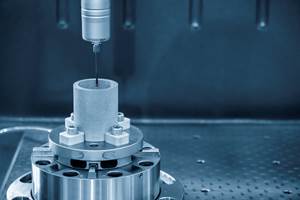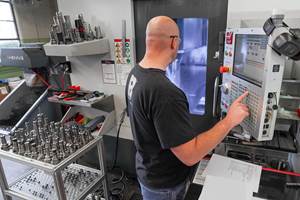Hold Multiple Parts In One Vise
Traditionally, machine tool buyers have relied heavily on machine tool distributors for advice on buying the equipment best suited to their particular needs. In today's Internet age, however, the buyer has unprecedented access to a world of information with which to make informed purchase decisions.
Share





Enhancements to the basic vise design have helped extend its usefulness. Soft jaws, serrated jaws, quick-change jaws and machinable jaws are among the enhancements that have been developed to help shops get more holding range from the standard table vise.
Until recently, however, securely holding more than two blanks in a vise has been somewhat limited. The reason is that secure grip of a blank requires balance of the gripping force of the movable jaw. Two parts can be set up in the vise--one to the right and one to the left of the vise centerline--no problem. But add a third blank, and unless they are very precise, one of the three parts will be less secure, often to the point of posing a safety hazard during the machining operation.
Costlier, dedicated, special fixturing has been the traditional answer to running more than "two-up." Of course, the more specialized fixtures become, the less flexible they are for different jobs. It's the opposite of a table vise.
A solution for this multiple part holding dilemma is available from Snap-Jaws Manufacturing (Troy, Michigan). It has developed a vise jaw set called Piston Jaw.
This new system uses a patent pending design that applies hydraulics through a series of internal passages in the jaw set to effectively and evenly clamp up to five workpieces on a single table vise. The body of the jaws contains a series of pistons, with O-ring seals, that float on the face of the jaw.
Two rows of clamping pistons are built into a 2-inch by 6-inch self contained steel housing. There are five pistons in each row spaced at a centerline distance of 0.75 inches above and below each other. Side to side centerline distance is 1.20 inches.
Behind these pistons are internal passages filled with hydraulic fluid. The key element of this system is its ability to hold similar parts that have different outside dimensions (up to 0.025 inch variability) with equal and adequate holding force.
Secondary oil passages connect a first chamber in the top row of pistons with a second chamber in the bottom row of pistons. This makes the flow of hydraulic fluid between the rows proportionally restricted to provide uniform holding force.
When workpieces are placed in between the pistons, they independently compensate for variation with the hydraulic fluid pressure equalizing and balancing the clamping force for each piston.
The assembly also uses a pin, inserted through the housing and slots in each upper and lower pair of pistons, to mechanically prevent the pistons from being forced out of the housing when clamping pressure is applied to the other pistons. It's a positive stop to prevent over travel of any of the pistons.
In application, this new jaw set can be fitted with a matching V-jaw to hold up to five parts at a time ranging from 3/8 inch to 1 3/16 inches in diameter, or three parts up to 2 inches in diameter using every other "V" position. With other jaw variations (soft or machined for example) hex, rectangular or irregular shaped parts can be secured.
Piston Jaw uses the Snap Jaw quick-change vise design for fast changeover. Moreover, the individual piston tips can be exchanged for different materials as applications warrant.
Serrated tips or brass, nylon, carbide and other materials can be used as the point of contact for virtually any material to be held in the vise. Even swivel tips can be used as needed.
Extending the flexibility of the table vise even further is the goal of this new workholding development. It's worth a look.
Related Content
Parts and Programs: Setup for Success
Tips for program and work setups that can simplify adjustments and troubleshooting.
Read MorePrioritizing Workholding Density Versus Simplicity
Determining whether to use high-density fixtures or to simplify workholding requires a deeper look into the details of your parts and processes.
Read MoreMedical Shop Performs Lights-Out Production in Five-Axes
Moving to five-axis machining enabled this shop to dramatically reduce setup time and increase lights-out capacity, but success relied on the right combination of workholding and automation.
Read MoreNavigating Large-Scale CNC Machining: Suburban Tool’s Niche Strategy to Stay Competitive
Facing increasing competition from lower-cost imports, Suburban Tool made a move toward large-scale, in-house machining. By identifying a niche in large, precision angle plates and tombstones, the company has strengthened its ability to control quality and protect its reputation.
Read MoreRead Next
How I Made It: Dennis Rymanowski
Dennis Rymanowski has worked at NSH USA for 60 years, with his passion for manufacturing living alongside his passion for his family’s polka band.
Read MoreA New Frontier in Surface Finish Control
What if your machine tool could measure surface roughness as it cuts? This article explores how in-process metrology is advancing from concept to reality, enabling real-time feedback, immediate detection of anomalies and new levels of control over surface quality. Discover the technologies making this possible.
Read More






















